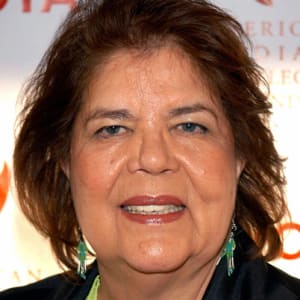
Wilma Mankiller
Wilma Mankiller worked for several years as a leading advocate for the Cherokee people, and became the first woman to serve as their principal chief in 1985.
Synopsis
Wilma Mankiller was born in Tahlequah, Oklahoma, on November 18, 1945. Four decades later, in 1985, Mankiller became the first female principal chief of the Cherokee Nation. She sought to improve the nation’s health care, education system and government. She decided not to seek re-election in 1995 due to ill health. After leaving office, Mankiller remained an activist for Native-American and women's rights until her death, on April 6, 2010, in Adair County, Oklahoma.
Younger Years
Born on November 18, 1945, in Tahlequah, Oklahoma, Wilma Pearl Mankiller was a descendant of the Cherokee Indians, the Native Americans who were forced to leave their homelands in 1830s; she was also of Dutch and Irish descent. She grew up on Mankiller Flats, located near Rocky Mountain, Oklahoma, before moving with her family in the mid-1950s to San Francisco, California, in hopes of a better life. Unfortunately, the family still struggled greatly in their new home due to dwindling finances and discrimination.
Mankiller attended Skyline College and San Francisco State University in California before enrolling at Flaming Rainbow University in Oklahoma, where she earned a bachelor's degree in social sciences. Thereafter, she took graduate courses at the University of Arkansas.
Early Roles
In 1963, at age 17, Wilma Mankiller married Hector Hugo Olaya de Bardi. The couple would later have two daughters: Felicia Olaya, born in 1964, and Gina Olaya, born in 1966.
In the 1960s, Mankiller was greatly inspired by the attempts by Native Americans to reclaim the island of Alcatraz to become more active in Native American issues. Always passionate about helping her people, she decided to return to Oklahoma in the mid-1970s, not long after filing for divorce from Olaya de Bardi. Soon after returning to her native state, she began working for the government of the Cherokee Indian Nation as a tribal planner and program developer.
In 1979, Mankiller nearly lost her life in a serious car accident, in which she was struck head on by her best friend. Her friend died, and though Mankiller survived, she underwent numerous surgeries as a part of a long recovery process. She then had to battle a neuromuscular disease known as myasthenia gravis, which can lead to paralysis. Once again, Mankiller was able to overcome her health challenges.
Cherokee Indian Nation's First Female Chief
Wilma Mankiller ran for deputy chief of the Cherokee Nation in 1983 and won, subsequently serving in that position for two years. Then, in 1985, she was named the tribe's principal chief—making history as the first woman to serve as principal chief of the Cherokee people. She remained on the job for two full terms thereafter, winning elections in 1987 and 1991. A popular leader, Mankiller focused on improving the nation's government, and health-care and education systems. Due to ill health, she decided not to seek re-election in 1995.
Later Career and Death
For more than two decades, Wilma Mankiller led her people through difficult times. After leaving office, she continued her activism on behalf of Native Americans and women. She also taught for a short time at Dartmouth College in New Hampshire.
Mankiller shared her experiences as a pioneer in tribal government in her 1993 autobiography, Mankiller: A Chief and Her People. She also wrote and compiled Every Day Is a Good Day: Reflections by Contemporary Indigenous Women (2004), featuring a forward by leading feminist Gloria Steinem. For her leadership and activism, Mankiller received numerous honors, including the Presidential Medal of Freedom in 1998.
Wilma Mankiller died on April 6, 2010, at the age of 64, in Adair County, Oklahoma. She was survived by her second husband, Charlie Soap, whom she married in 1986.
After learning of Mankiller's passing in 2010, President Barack Obama issued a statement about legendary Cherokee chief: "As the Cherokee Nation's first female chief, she transformed the nation-to-nation relationship between the Cherokee Nation and the federal government, and served as an inspiration to women in Indian Country and across America," he stated. "Her legacy will continue to encourage and motivate all who carry on her work."




